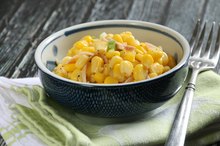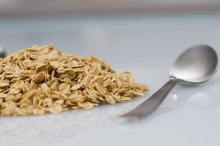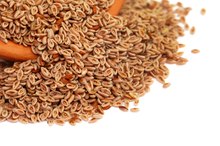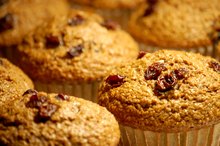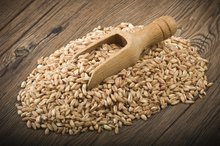What does fact checked mean?
At Healthfully, we strive to deliver objective content that is accurate and up-to-date. Our team periodically reviews articles in order to ensure content quality. The sources cited below consist of evidence from peer-reviewed journals, prominent medical organizations, academic associations, and government data.
- Harvard School of Public Health: Fiber: Start Roughing It! – The Nutrition Source – What Should You Eat?
- Centers for Disease Control and Prevention: Nutrition for Everyone: Basics: Carbohydrates
The information contained on this site is for informational purposes only, and should not be used as a substitute for the advice of a professional health care provider. Please check with the appropriate physician regarding health questions and concerns. Although we strive to deliver accurate and up-to-date information, no guarantee to that effect is made.
Wheat Bran: What Foods are High in Wheat Bran Fiber?
With 12 g of fiber per half cup, wheat bran may be one of the most fiber-rich foods you can eat. That half cup holds 48 percent of the recommended daily fiber intake of 25 g for women, and 32 percent of the recommended intake of 38 g for men. The fiber in wheat bran is insoluble, meaning that your body can’t digest it. However, fiber plays important roles in digestion and disease prevention. Wheat bran also provides protein, iron, B vitamins, potassium, magnesium, phosphorous and zinc.
Breads
Wheat bran is the outer layer of the wheat kernel, which is removed from the grain during milling. The bran is reserved as a separate product to add fiber, vitamins and minerals to other foods, such as bread. You can also get wheat bran from whole-grain wheat products because whole grains retain their bran. Two slices of bread made with wheat bran offer 3 g of dietary fiber, according to the US Department of Agriculture.
- Wheat bran is the outer layer of the wheat kernel, which is removed from the grain during milling.
- The bran is reserved as a separate product to add fiber, vitamins and minerals to other foods, such as bread.
Cereals
Wheat Chex Cereal Nutrition Information
Learn More
Replacing sugary breakfast cereals or pastries with high-fiber cereals is a good way to add fiber to your diet, says the Harvard School of Public Health 1. Many ready-to-eat breakfast cereals offer wheat bran that boosts their fiber content. The fiber in wheat bran promotes healthy digestion by adding bulk to your stools and helping digestive wastes pass through your colon. A 1/3-cup serving of 100 percent wheat bran cereal offers 18 g of dietary fiber.
- Replacing sugary breakfast cereals or pastries with high-fiber cereals is a good way to add fiber to your diet, says the Harvard School of Public Health 1.
- The fiber in wheat bran promotes healthy digestion by adding bulk to your stools and helping digestive wastes pass through your colon.
Muffins and Bagels
Muffins made with wheat bran may be high in fiber, but you may also get more fat, sugar and calories than you bargained for when you buy a commercially made bran muffin. A bran muffin that you might buy at a coffee shop may have a healthy 6 g of fiber, but the muffin also has 19 g of fat and 420 calories. For a low-fat break from your usual morning toast or cereal, try a bagel made with wheat bran. If you’re trying to increase your daily fiber intake, drink at least eight glasses of water per day to prevent bloating, gas or constipation, advises the HSPH.
- Muffins made with wheat bran may be high in fiber, but you may also get more fat, sugar and calories than you bargained for when you buy a commercially made bran muffin.
Homemade Recipes
How to Eat Ground Flaxseed
Learn More
You can increase the fiber content in homemade foods by adding wheat bran to rolls, fruit breads, pancakes or even cookies. Wheat bran adds a hearty texture to your recipes, as well as protecting your digestive and cardiovascular health. You can also sprinkle a spoonful of wheat bran over dry cereals, stir it into hot cereals or blend it with fruit smoothies. A high dietary fiber intake has been linked to lower risks of heart disease, type 2 diabetes and metabolic syndrome, says the HSPH.
- You can increase the fiber content in homemade foods by adding wheat bran to rolls, fruit breads, pancakes or even cookies.
- Wheat bran adds a hearty texture to your recipes, as well as protecting your digestive and cardiovascular health.
Related Articles
References
- Harvard School of Public Health: Fiber: Start Roughing It! – The Nutrition Source – What Should You Eat?
- USDA National Nutrient Database: Wheat Bran, Crude, 0.5 Cup
- U.S. Department of Agriculture. Wheat bran, crude. In: FoodData Central. Updated April 1, 2019.
- Francis CY, Whorwell PJ. Bran and irritable bowel syndrome: time for reappraisal. Lancet. 1994;344(8914):39-40. doi:10.1016/s0140-6736(94)91055-3
- Ford AC, Moayyedi P, Lacy BE, et al. American College of Gastroenterology monograph on the management of irritable bowel syndrome and chronic idiopathic constipation. Am J Gastroenterol. 2014;109 Suppl 1:S2-26. doi:10.1038/ajg.2014.18
- Mayer EA, Savidge T, Shulman RJ. Brain-gut microbiome interactions and functional bowel disorders. Gastroenterology. 2014;146(6):1500-12. doi:10.1053/j.gastro.2014.02.037
- Marsh A, Eslick EM, Eslick GD. Does a diet low in FODMAPs reduce symptoms associated with functional gastrointestinal disorders? A comprehensive systematic review and meta-analysis. Eur J Nutr. 2016;55(3):897-906. doi:10.1007/s00394-015-0922-1
- El-Salhy M, Ystad SO, Mazzawi T, Gundersen D. Dietary fiber in irritable bowel syndrome (Review). Int J Mol Med. 2017;40(3):607-13. doi:10.3892/ijmm.2017.3072
- Cockerell KM, Watkins AS, Reeves LB, Goddard L, Lomer MC. Effects of linseeds on the symptoms of irritable bowel syndrome: a pilot randomised controlled trial. J Hum Nutr Diet. 2012;25(5):435-43. doi:10.1111/j.1365-277X.2012.01263.x
- Cozma-Petruţ A, Loghin F, Miere D, Dumitraşcu DL. Diet in irritable bowel syndrome: What to recommend, not what to forbid to patients. World J Gastroenterol. 2017;23(21):3771. doi:10.3748/wjg.v23.i21.3771
- Ford AC, Moayyedi P, Lacy BE, et al. American College of Gastroenterology monograph on the management of irritable bowel syndrome and chronic idiopathic constipation. Am J Gastroenterol. 2014;109(S1):S2-26. doi:10.1038/ajg.2014.187
Resources
Writer Bio
Anne Tourney specializes in health and nutrition topics. She is a registered nurse with experience in medical-surgical nursing, behavioral health and geriatrics. Tourney earned a Bachelor of Science in nursing from Regis University.


